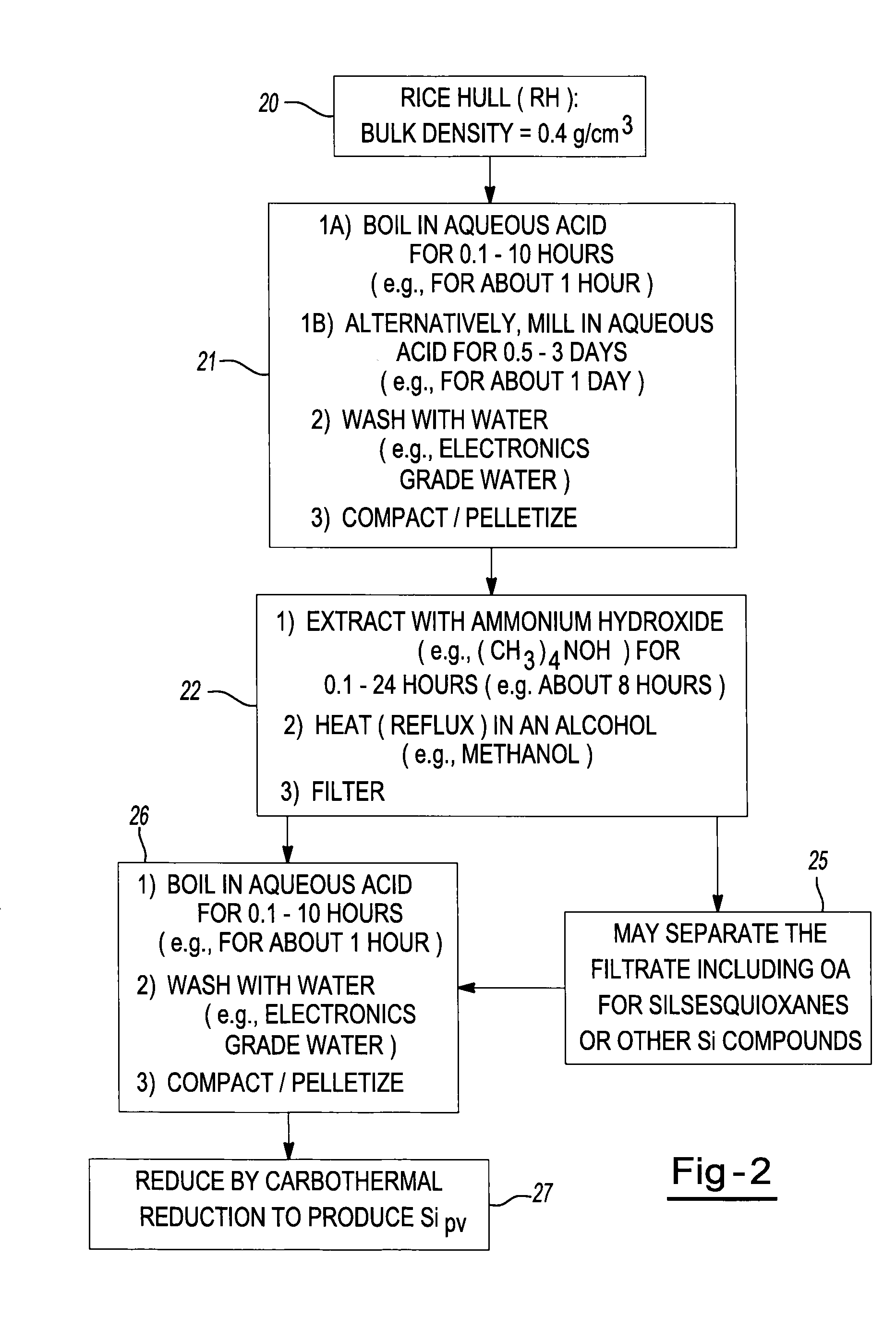Low cost routes to high purity silicon and derivatives thereof
a technology of high purity silicon and low cost, applied in the field of high purity silicon, can solve the problems of high cost driven in part by limited supply of photovoltaic grade silicon, high cost of high-purified silicon needed for pv cells, and increase the reaction rate, the effect of reducing the reaction tim
- Summary
- Abstract
- Description
- Claims
- Application Information
AI Technical Summary
Benefits of technology
Problems solved by technology
Method used
Image
Examples
example 1
AWPCL to High Purity Si Via Electric Arc Processing
[0076]Impurities are removed from a sample of an AWP having a molar ratio of carbon to silica from 5:95 to 60:40 using an acid wash followed by a boiling water wash. The AWP is then reacted with an ammonium hydroxide so that some of the silica is extracted and an AWPcl is formed having an increased molecular ratio of carbon to silica. The AWPcl is next compacted to produce bricks or rods. As such, the invention may be characterized as being free of any high purity arc electrodes other than the compacted AWPcl electrodes. The compacted AWPcl is conductive and is used as the arc electrodes. then run through an arc furnace such that molten silicon, is produced (e.g., using the chemical process described in reaction (1)) and is isolated in a SiC mold designed to catch the product but filter off any detritus including SiC. The arc furnaces operate by passing an arc directly through the AWPcl causing it to be heated to a temperature great...
example 2
[0077]Example 1 is repeated except an induction furnace is used instead of the arc furnace. It is expected that a molten silicon metal is produced having an expected purity greater than about 99.99 weight percent. As such, one aspect of the invention, is a process including a step of reducing silica uses an electric arc furnace, an induction furnaces, or both. Without being bound by theory, it is believed that at large scales, electricity usage may be lower for an electric arc furnace than for an induction furnaces. Additionally, it is expected that the capital costs for an arc furnace will be lower than for an induction furnace.
example 3
Electric Generation / Carbothermal Reduction
[0078]A quantity of rice hulls is burned in an electricity generating process that produces a quantity of electrical energy and a quantity of rice hull ash. The quantity of rice hull ash is converted into AWPcl and then into a high purity silicon metal (e.g., a Sipv) using an induction furnace. The electricity required for running the induction furnace is expected to be less than the quantity of electricity produced from burning the rice hulls. As such, the invention contemplates regenerating electricity as a by-product of the reactions. Furthermore the process may be characterized by one, two, or more steps (e.g., all steps, or the process in its entirety) that completely uses renewable resources (e.g., for energy, for silicon source, for carbon source, or compacted AWP, rod to produce molten silicon (e.g., molten Sipv). The induction melting includes a step of passing a compacted rod of AWPcl through (e.g., vertically) an electric field (e...
PUM
| Property | Measurement | Unit |
|---|---|---|
| Temperature | aaaaa | aaaaa |
| Temperature | aaaaa | aaaaa |
| Temperature | aaaaa | aaaaa |
Abstract
Description
Claims
Application Information
 Login to View More
Login to View More - R&D
- Intellectual Property
- Life Sciences
- Materials
- Tech Scout
- Unparalleled Data Quality
- Higher Quality Content
- 60% Fewer Hallucinations
Browse by: Latest US Patents, China's latest patents, Technical Efficacy Thesaurus, Application Domain, Technology Topic, Popular Technical Reports.
© 2025 PatSnap. All rights reserved.Legal|Privacy policy|Modern Slavery Act Transparency Statement|Sitemap|About US| Contact US: help@patsnap.com



